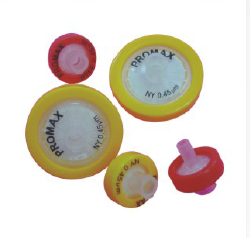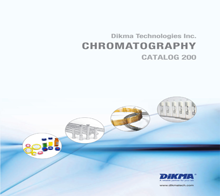- Home
- Products
- Sample Preparation
- ProMax™ Syringe Filters
ProMax™ Syringe Filters
ProMax™ Syringe Filters
|
• Broad range of membrane types • HPLC / GC sample and solvent filtration • Standard Luer lock • Ultra-clean polypropylene housing, low dissolution, for trace analysis • Low residual volume • Convenient, cost-effective |
 |
Particulates can damage expensive equipment, valves, columns and pumps. They can also lead to erratic analytical results. Pre-filtering samples prior to analysis is critical in preventing column and frit blockage, undue wear on valve seals, and abnormally high operating pressures.
ProMax™ syringe filters are designed for economical, rapid filtration of almost any solution prior to analysis. The housing attaches to any standard Luer lock syringe, so the sample can be pushed through the membrane under pressure. The resulting eluent is free from particulates and ready for use in HPLC, GC or other analytical techniques.
ProMax™ syringe filters are available in a broad range of pore sizes and membrane types. All are non-sterile. Filters made with 13 mm or 25 mm membranes are suitable for use with samples of 1 mL or greater. All filters are available in CA, NY, PVDF, PES, GF or PTFE membranes.
ProMax™ Syringe Filters Specifications

ProMax™ Filter Membrane Selection Guide
| Membrane Type | Application |
| Cellulose Acetate (CA) | Hydrophilic membrane, uniform pore size, high porosity, small resistance, fast filtration rate, minimal adsorption. Mainly used to filter particles and bacteria in biological and watersoluble samples |
| Nylon (NY) | For general sample and solvent filtration. Nylon has inherent hydrophilic characteristics and works well with aqueous as well as most solvent-based samples. Nylon is excellent for most HPLC and GC sample and solvent preparations |
|
Polysulfone and Polyvinylidene Difluoride (PVDF) - Not Sterilization |
Hydrophobic membrane, exhibits very low protein binding. It can be used for general biological sample filtration. PVDF is especially useful in HPLC sample preparation and is highly resistant to most solvents. Polysulfone has very limited resistance to solvents and is generally used for aqueous-based biological samples. This membrane exhibits good flow rate characteristics |
| Polyethersulfone (PES) | PES hydrophilic membrane with fast flow, high-throughput characteristics, and ultra-low protein binding. It is ideally suited for use in life sciences applications. Recommended for filtering critical biological samples, tissue culture media, additives, and buffers. Ideal for hard-to-filter solutions. Use mainly with aqueous solutions |
| Polytetrafluoroethylene (PTFE) | An inherently hydrophobic membrane that is good for filtration of organic-based, highly acidic or basic sample and solvents. Widely used for chromatography, and for clarification of non-aqueous samples. Although this membrane is hydrophobic, it can be made hydrophilic by wetting the membrane with alcohol and then flushing with de-ionized water |
| Glass Fiber (GF) | For general sample and solvent filtration, pore size 10 μm, use for removing larger particulates or filtration of high viscosity sample. Compared with the standard membrane, GF pre-filters can provide higher throughput |
Chemical Compatibility
.jpg)
USA
11 Orchard Road, Suite 106
Lake Forest, CA 92630, USA
Tel: 949-716-5810
Fax: 949-716-5811
Toll-Free: 1-877-328-8348
Email: sale@dikmatech.com
Business hours: 9 AM - 5 PM PST
Canada
255 Shields Court, Unit A
Markham, ON L3R 8V2, Canada
Tel: 905-944-8066
Fax: 905-944-0181
Toll-Free:1-866-889-9072
Email: sales@dimaglass.com
Business hours: 9 AM - 5 PM EST
Korea
FRABJES WANDELN
E-mail: wyoh@frabjes.com
